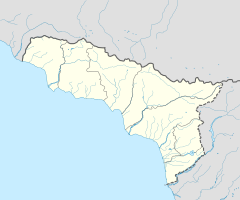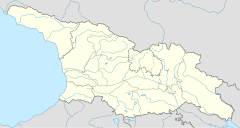Chlou Holy Cross Church
| Chlou Holy Cross Church ჭლოუს ჯვარი პატიოსანი (in Georgian) | |
|---|---|
| Religion | |
| Affiliation | Georgian Orthodox |
| Province | Abkhazia[1] |
| Ecclesiastical or organizational status | ruins |
| Location | |
| Location | |
| Geographic coordinates | 42°52′50″N 41°29′45″E / 42.88056°N 41.49583°E |
| Architecture | |
| Type | Church |
| Completed | 14-15th century |
The Chlou Holy Cross Church (Georgian: ჭლოუს ჯვარი პატიოსანი, romanized: ch'lous jvari p'at'iosani) is a ruined medieval church on the right bank of the Duabi river in the village of Chlou in Ochamchire Municipality, Abkhazia, an entity in the South Caucasus with a disputed political status. [2]
Description of the ruins
[edit]The church stands 20 km north of the town of Ochamchire on a hill overlooking the Duabi river and is surrounded by a large defensive wall built of large cobblestone. In some places the height of the wall is over 3 meters, the total length of the walls is 500 meters. The western wall of the fence runs through the river. The church walls have survived, but are gravely damaged. It is a hall-church design with a semi-circular apse on the east. The vault has collapsed. The ruins are covered with shrubs of bushes.
History
[edit]The church was likely built in the 14th or 15th century, but wall ornamentation may indicate an earlier date of the 11th-12th century.[3] A stone slab found in the ruins display a Georgian inscription in the asomtavruli script, which is dated roughly to the 14th century when the area was under the sway of the Dadiani family of Mingrelia. It commemorates a high-ranking nobleman (eristavt-eristavi) whose name is reconstructed as Ozbeg Dadiani.[4][5]
External links
[edit]- Chlou Holy Cross Church. Historical monuments of Abkhazia — Government of the Autonomous Republic of Abkhazia.
References
[edit]- ^ The political status of Abkhazia is disputed. Having unilaterally declared independence from Georgia in 1992, Abkhazia is formally recognised as an independent state by 5 UN member states (two other states previously recognised it but then withdrew their recognition), while the remainder of the international community recognizes it as de jure Georgian territory. Georgia continues to claim the area as its own territory, designating it as Russian-occupied territory.
- ^ Holy Cross church in Chlou village Historical monuments of Abkhazia — Government of the Autonomous Republic of Abkhazia.
- ^ Kapanadze, Salome, ed. (2007). Georgian Cultural Heritage. Book1. Abkhazeti. Tbilisi: Ministry of Education and Culture of Abkhazia. p. 111.
- ^ Bgazhba, Khukhut Solomonovich (1967). Из истории письменности в Абхазии [From the History of Writing in Abkhazia] (PDF) (in Russian). Tbilisi: Metsniereba. p. 24.
- ^ Tugushi, Abesalom (1983). "ერთი წარწერის წაკითხვა-დათარიღებისათვის" [For reading and dating one inscription] (PDF). Dzeglis Megobari (in Georgian). 62: 35–36.


